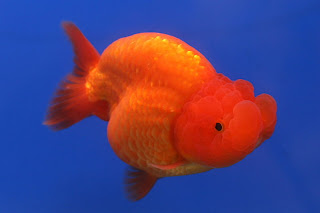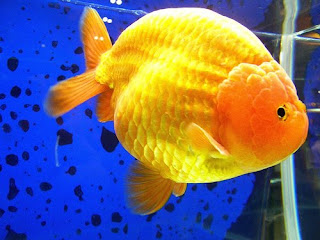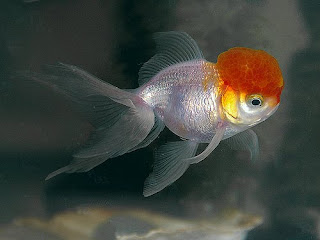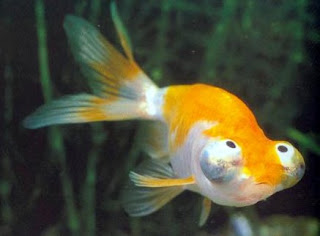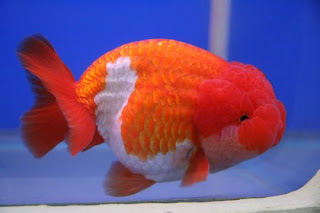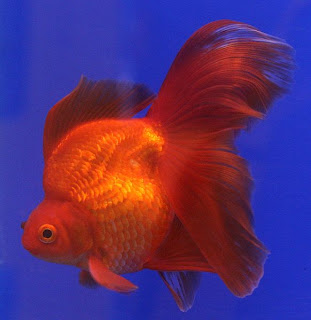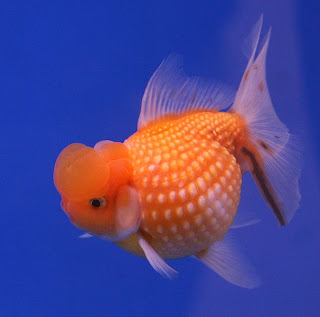A variety of charming
golden fish for our vision, and not ending they dazzle and delight our eyes.
There are several varieties of golden fish unique unique and funny, golden fish is
freshwater fish ...
Just Sharing info ...
1.Bubble Eye / Suihogan Goldfish:
Unique species of
goldfish that comes from China these have eyes pointing upwards and 2 large bags filled with fluid, these fish have no fin on his back, goldfish can grow 6 -8 inches.
2.Ranchu Goldfish:Goldfish with an unusual appearance is referred to as the "
king of gold fish" by the Japanese. Ranchu is the result of cross breeding experiments that differ from Lionhead China. These fish have no fin on, and have many colors such as orange, red, white, red-and-white, blue, black, black-and-white, black-and-red, pale fish with yellow bodies and red heads are very rare and rare.
3.Butterfly tail / Jikin Goldfish:Beautiful and adorable but rare, jikin believed from Japan. The most prominent characteristic is
tail which has the form X. long tail has a distinctive bow tie, or torpedo-shaped cigar.
White body with the lips, red fins and gills. can grow to 9 inches.
Another name is the tail of the Peacock and Rokuri.
4.Telescope Eye / Demekin Goldfish:This species has large eyes and unique, this variation is red, red and white, calico, black and white, brown, blue, lavender, chocolate-and-blue and black color.
They may also sometimes have a metallic scales. Although his eyes big, bad eyesight and better not mixed a aquarium with other types of agile and placed in akurium without pointy objects.
5.Oranda Goldfish:Ornamental, unique
goldfish from China and Japan, characterized by a hood like raspberries dikepalanya.
Goldfish are very famous all over the world, and have a great body with 4 long tails
6.Celestial Eye / Choten gan Goldfish:One of the odd goldfish from China and Korea.Mata goldfish is like a
telescope eye goldfish, but pointing upwards The body is shaped like a torpedo fish, and no fins on.
7.Lionchu/Lionhead Goldfish:Unique goldfish is a goldfish that has no fins on the Thai and the result of cross breeding between
lionheads and ranchus. Has a great body, wide and curved to the rear and a large head.
8.Ryukin Golfish:Brightly colored goldfish and withdraw from Japan is a fin that amount 2 times the body length, snout is pointed and his back bent
Ryukin have colors like maroon, red and white, white, metallic and calico color. A good aquarium maintenance in these fish can reach up to 8 inches or 21 cm.
Another nickname is Ribbontail Japan, Fringetail, Fantail or Veiltail
9.Calico/Nacreous Goldfish:Goldfish named
Calico or Nacreous has a mix of metallic and transparent color scales that give the impression of pearls.
Calico can grow to 12 inchi.Coraknya consist of patches of red, yellow, gray and black with dark spots and blue.
10.PomPom/Hanafusa Goldfish:Hanafusa have flesh that grows like a pom pom around his nose, his body like
Lionhead, but that grows is her nose, and sometimes even have flesh that grows up through the lower jaw
11.Chinsurin / Pearlscale Goldfish:Goldfish this one punysa scales speckled spots and colored pearls,
originated from Japan and called Chinsurin
Unique Facts about Golden Fish :
* Digestive goldfish is very simple, and very hard to digest protein
* Chef goldfish can change the color of the body, according to the place where they are stored or maintained
* Goldfish chef produces pigment when exposed to light. If the fish Mas placed in the dark, he would seemingly be brighter in the morning, and when repeatedly placed in a dark place, then the goldfish will lose its color.
* Chef goldfish can grow up to maximum length of 58.42cm and weighs 4.5 kg
* Goldfish chef longest ever measured 47.7 cm long, from snout to tail, in the Netherlands
* Chef goldfish can live to 20 years, but pet goldfish only live 6 to 8 years (healthy lifestyle ga ya?)
* Chef's oldest goldfish ever recorded 49-year-old
* Chef can live goldfish in the pond surface freezes, long as there is enough oxygen and water is not fully hardened
* In Italy there are laws that prohibit the use of goldfish as prizes carnival
* In Rome prohibited from maintaining a goldfish in a jar, because according to them very cruelly confining fish in a place like that.
Source : http://wong168.wordpress.com






















